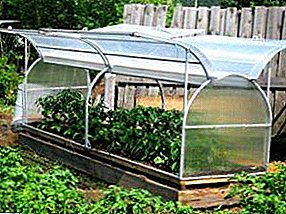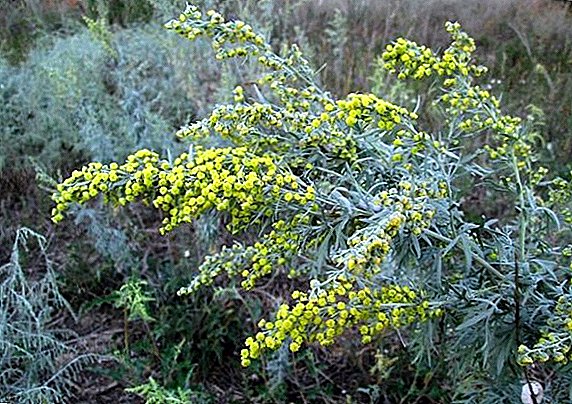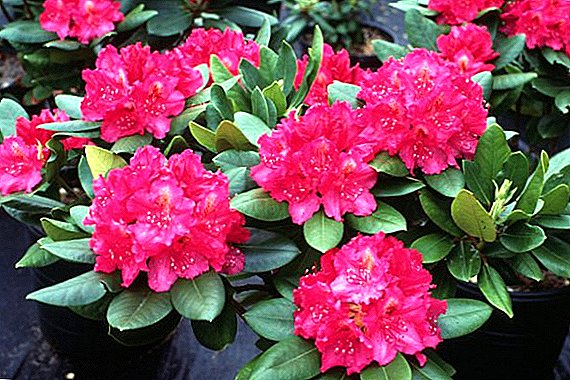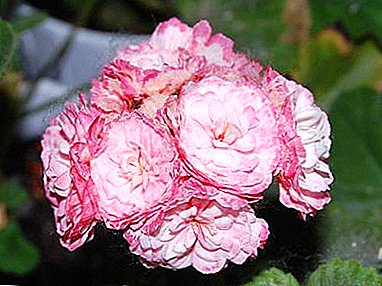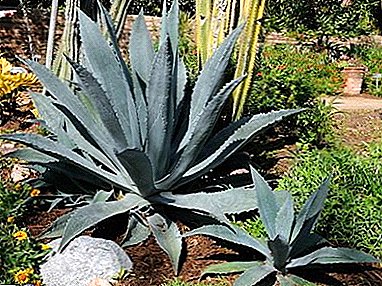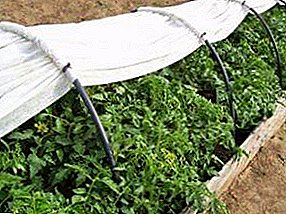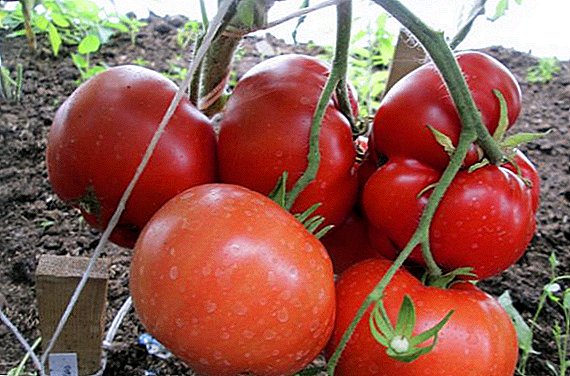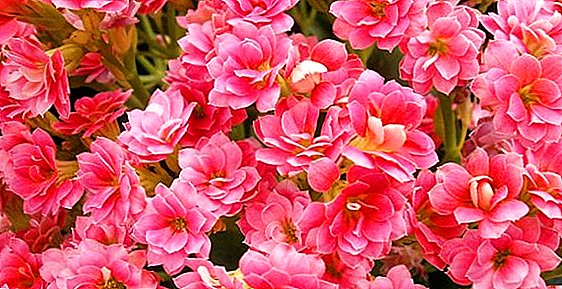 At home, only a few Kalanchoe varieties are grown: Cirrus, Blosfeld, Single-flowered and Daygremonta. But whichever of these species grow in your home, the care of the plant will be about the same.
At home, only a few Kalanchoe varieties are grown: Cirrus, Blosfeld, Single-flowered and Daygremonta. But whichever of these species grow in your home, the care of the plant will be about the same.
Terms of content Kalanchoe
Representatives of the "home" Kalanchoe belong to the family of Crassulaceae, they all come from the tropics, and therefore unpretentious, can do for a long time both without moisture and in a humid environment. To survive in an extreme climate zone, the leaves of the plant accumulate water during the rainy period, and then economically use it. Kalanchoe does not need scrupulous care at home, this plant does not require frequent transplantation and many fertilizers.
Important! If you do not know what to do when the Kalanchoe turns yellow, then first try to identify the cause. There may be several options: errors in planting, inappropriate soil, poor placement of the plant, non-compliance with the temperature regime, improper watering, lack of or excess of minerals.
Lighting
 Since a tropical plant is unpretentious, any place in the house where the sun's rays fall is suitable for it, special lighting is not required for Kalanchoe. The plant feels great in a bright and semi-dark room.
Since a tropical plant is unpretentious, any place in the house where the sun's rays fall is suitable for it, special lighting is not required for Kalanchoe. The plant feels great in a bright and semi-dark room.
Did you know? If the Kalanchoe is standing in a well-lit sunny place, then the leaves will acquire a reddish shade over time.
Ideal - to put a flower on the windowsill of the east or west window. It is desirable to provide flowering species with plenty of sunshine in winter. If the Kalanchoe is clearly deficient in light, it weakens. The lower leaves fall, and the upper ones turn pale.
Temperature conditions
 For a comfortable existence of the plant, the temperature regime is fairly free. When on the street above 10 ° C, it can be safely carried out on the balcony and left there until autumn. The plant suffers heat and drought normally, but at this time it is worth watering it a little more often. The most favorable temperature for Kalanchoe in the summer is 23-25 ° C, and in the cold period it is 12-16 ° C.
For a comfortable existence of the plant, the temperature regime is fairly free. When on the street above 10 ° C, it can be safely carried out on the balcony and left there until autumn. The plant suffers heat and drought normally, but at this time it is worth watering it a little more often. The most favorable temperature for Kalanchoe in the summer is 23-25 ° C, and in the cold period it is 12-16 ° C.
Air humidity
Humidity in your room - the least important indicator for the normal existence of Kalanchoe, because the plant can keep water in the leaves. Thanks to this, Kalanchoe easily tolerates drought. One has only to ensure that the water does not fall on the leaves from above, as this can provoke a disease of the plant.
Care Kalanchoe at home
The plant does not require much effort from you, but only regular simple procedures and understanding how to care for Kalanchoe in winter and summer.
Watering the soil: winter-summer
 Land in a pot should be watered abundantly so that the water completely soaked it. But the surplus needs to be drained, because the soil should dry well between irrigations. In the hot summer period, water procedures should be made more frequent, and in winter, water Kalanchoe every 2 weeks. If the plant is overfilled, it can lead to the formation of rot and mold fungi, and its roots will quickly deteriorate.
Land in a pot should be watered abundantly so that the water completely soaked it. But the surplus needs to be drained, because the soil should dry well between irrigations. In the hot summer period, water procedures should be made more frequent, and in winter, water Kalanchoe every 2 weeks. If the plant is overfilled, it can lead to the formation of rot and mold fungi, and its roots will quickly deteriorate.
It is not necessary to spray room Kalanchoe. In winter, such a procedure can generally harm the plant. But in order to remove dust from the leaves, the flower must be periodically cleaned with a soft cloth.
Important! If only the lower leaves of Kalanchoe dry up, and everything is fine with the upper ones, pay attention to the volume of the florist in which the plant lives. If the pot is small and crowded closely, it may be dying out due to lack of food. Even the leaves of Kalanchoe can dry out if in winter the flower is near a warm battery.
Top dressing of a flower

About once a month, Kalanchoe should be fertilized with compounds that are well suited for succulents. If you are the owner of a flowering plant, reinforce it with complex fertilizer, otherwise Kalanchoe will not bloom. We advise you to use only half the dose indicated on the package, and in the winter, you should not fertilize the Kalanchoe at all.
Important! After you find the buds in Kalanchoe, the lighting can not be limited, and the plant can be watered as usual.
Pruning Kalanchoe
Be sure to cut the flowering kalanchoe, because during this period the plant weakens. The peduncle must be cut to the ground so that the part that remains will not rot. All areas of the plant that look bad, do not be afraid and do not regret to let under the scissors, and the young shoots - to root.
In the summer, it will be nice to pin the tops of Kalanchoe so that shoots are formed on the sides. If this is not done, the plant will acquire an ugly shape and will grow.
Proper transplantation is the key to good growth.
 Let's now consider how to spread out Kalanchoe at home. It is not difficult at all. The flower needs a transplant once a year, at the end of March. In the pots to adult plants, you can pour new earth, but the roots should not go beyond the borders of the florist.
Let's now consider how to spread out Kalanchoe at home. It is not difficult at all. The flower needs a transplant once a year, at the end of March. In the pots to adult plants, you can pour new earth, but the roots should not go beyond the borders of the florist.
You need to replant the plant in a pot that is about 2-3 cm more than the previous one. Carefully remove the plant from the old "house", remembering that it has fragile stems and leaves. To transplant Kalanchoe you need the following soil composition: sand, leaf soil, turf ground - in proportions of 1: 1. You can add a little humus.
Breeding Kalanchoe
Reproduction of Kalanchoe at home can be done in different ways, the most popular and effective of them: cuttings, children and seeds. Not every way is universal and suitable for any type of Kalanchoe.
Cuttings
Kalanchoe Blossfelda pleases the eye with a beautiful bloom. This type of plant is recommended not only to propagate by cuttings, but also to be updated after each flowering. From the top of the shoots need to grow new plants. After all, this Kalanchoe quickly grows and stretches, and therefore loses its attractive appearance. In addition, after flowering on the plant remains bald spots.
For grafting suitable another group of plants with branching thin stems. Its most famous representative is Kalanchoe Mangina. To grow a thick bush plant, it must often be cut. Cut parts will be cuttings.
 The appearance of an adult plant depends on the shape of the cutting, so be very serious about choosing young shoots. They should be about 8 cm in length with lush beautiful leaves. Planting need to stalk so that the lower leaves lay on the surface of the soil. Bald part of the escape can be shortened to the desired size. When the seedling is rooted, it needs to be pinched in order to get a beautiful lush bush.
The appearance of an adult plant depends on the shape of the cutting, so be very serious about choosing young shoots. They should be about 8 cm in length with lush beautiful leaves. Planting need to stalk so that the lower leaves lay on the surface of the soil. Bald part of the escape can be shortened to the desired size. When the seedling is rooted, it needs to be pinched in order to get a beautiful lush bush.
Did you know? What to do if Kalanchoe dries up? Just break off the top, stick it into the ground, and you will have a new flower!
Children
This breeding method is used for viviparous varieties, such as the Kalanchoe pinnate and Kalanchoe Degremona. In these species brood buds are formed on the leaves - small plants with a shaped rosette of tiny leaves and thin roots. Having reached the required size, they fall from the parent sheet and take root in the soil. These are the kids you need for new copies. Moreover, they can be planted in the ground immediately.
Seeds
 Kalanchoe felt or Kalanchoee feathery refers to exotic species. Such adult plants are difficult to find on sale, so they are propagated by seed. The best time for this is February or March. Seeds scatter on top of the soil, which consists of peat and sand. Then it should be covered with glass and put on light, the air temperature should not exceed 20 ° C. Seedlings need to regularly moisturize and air. After they grow up, transplant in a special soil.
Kalanchoe felt or Kalanchoee feathery refers to exotic species. Such adult plants are difficult to find on sale, so they are propagated by seed. The best time for this is February or March. Seeds scatter on top of the soil, which consists of peat and sand. Then it should be covered with glass and put on light, the air temperature should not exceed 20 ° C. Seedlings need to regularly moisturize and air. After they grow up, transplant in a special soil.
Diseases and pests of Kalanchoe, ways to combat them
Kalanchoe, like all home plants, is prone to diseases and attacks of pests. If the kalanchoe dies, and you don’t know what to do, you will find a list of common diseases and methods for treating these plants.
- Spice ring virus. It affects the leaves. Light spots appear on them. Fight this disease through isolation and destruction of affected plants.
- Anomalous growth virus. Young leaves become light, and old - coarse and ugly. Affected plant must be destroyed.
- Green petals. During flowering petals become small and green. To overcome the virus is almost impossible, so the plant must be isolated and destroyed.

- Multi claw ticks. Leaves and cuttings affects brown scab. Leaves harden, bend, do not grow. Small white mites appear on them. To prevent infection, you need to regularly inspect the plant. At the first signs of infection - treat Kalanchoe soap. If the lesion is in an advanced stage, the drugs "Lightning", "Fitoverm", "Akarin", and "Vertimek" will help.
- Mealy dew. On the leaves appears white bloom, like flour. The disease affects flowers, and the plant takes on a brown color. Kalanchoe needs to be treated with biological fungicides, and when it is running, the drugs “Strobe”, “Tiovit Jet”, “Topaz” will help.
- Gray rot. Affected areas of the plant become soft and transparent. If the humidity is high, a gray patina may appear. To destroy the rot, it is necessary to remove the dying parts of the plant. In winter, try to reduce the humidity in the apartment. Kalanchoe must be in a dry state so that dew does not form. Do not spray the plant. This problem also shows the drugs "Chistotsvet" and "Scor."

- Ticks. Yellow droplets appear on the leaves of the affected plants, after which the leaves become discolored and dry. Young shoots are deformed. Small pests live on the underside of the leaf on the web. To avoid mites, the plant should not be in a room with high temperature and dry air. In case of weak defeat, treat Kalanchoe with soap, and in a more difficult situation, Akarin, Lightning, Vertimek, Fitoverm will help you.
- Stem rot. On the shoots and leaves form black watery specks. The infected plant must be isolated and sprayed with the preparations "Saprol" or "Rovral". If they did not help, then the sick Kalanchoe will have to be destroyed.
- Late blight. The affected parts of the plant wither and die. The rot begins to infect the base of the stem and passes to the leaves. Sick plants need to be destroyed, and the remaining contain in a dry place.
- Aphid. The leaves twist and turn yellow. When running form visible discharge aphids. Weakly affected areas are washed with soapy water, and in severe cases they are treated with Iskra, Komandor, Detsis, Tanrek, Actellic or tobacco dust.
- Cheesebone. On the streaks of leaves and petioles, white discharges are formed, similar to wax. On them live worms. Sick plants isolate and spray leaves with mineral oil.
Despite its "Spartan" origin and upbringing, Kalanchoe, like all home plants, needs proper and regular care. If you follow our recommendations, it will delight with its beauty and pomp.




